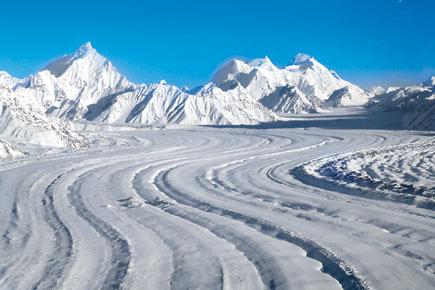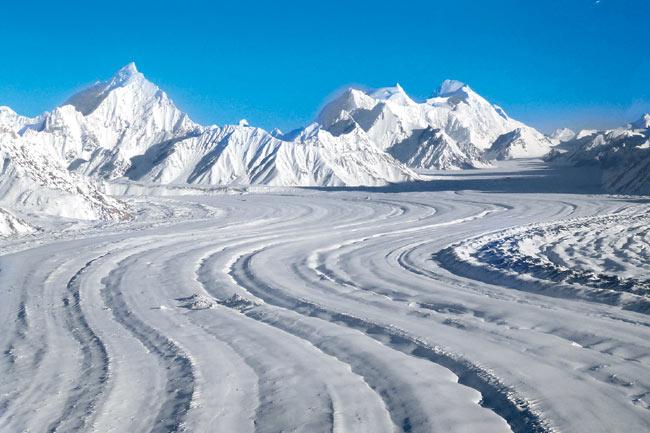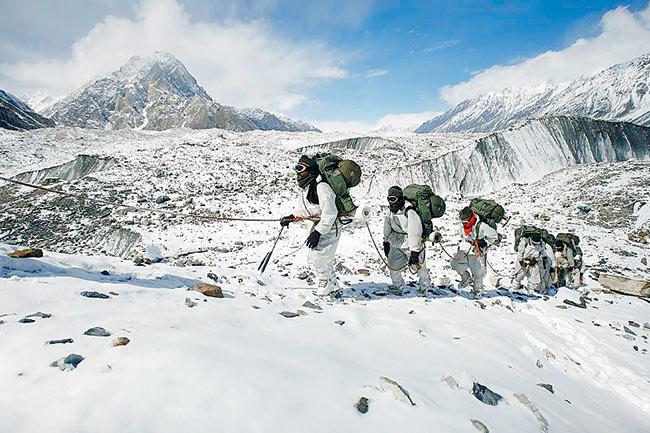How a stranded chopper was brought back from under the nose of the enemy, from Nitin A Gokhale’s book, Beyond NJ9842: The Siachen Saga

‘Flying here is certainly not for the faint hearted’
3rd June 1990: Two Cheetah helicopters of the Indian Air Force (IAF) are on a regular air maintenance run to the Siachen glacier. As was the routine by that time — six years into Operation Meghdoot — the first shuttles were to Amar and Sonam posts, the two highest helipads on the Siachen Glacier, located at altitudes in excess of 20,000 feet above mean sea level.

Shelling
Flt Lt B Ramesh and Flying Officer Naresh were leading the run and were supposed to land at Sonam. Flt Lt WVR Rao and Flying Officer Suresh Nair, in the second Cheetah, were scheduled to touch down at Amar, not very far from Sonam.
Rao remembers that day to be slightly warmer than usual at about 10 degrees, high for the glacier but understandable in the summer months. “At those heights, when temperature goes beyond 5 degrees, the ‘density altitude’ at Amar and Sonam is actually close to 23,000 feet, the ultimate limit at which these helicopters can and should fly. But in those conditions we could carry barely 5 kg load on the Cheetah. The rising temperature can have such an impact on the load carrying capacity of the helicopters,” he remembers. Rao and Nair landed normally at Amar but as they revved up to take off the helicopter engine ‘surged’ and the machine just sat down on the helipad.
“Amar is hardly 3000 metres from a Pakistani post located at a lower altitude. Even as we were struggling to figure out what went wrong, shelling from Pakistani post started. Remember those were pre-ceasefire days,” Rao reminisced.
Evacuation
The two pilots quickly ducked inside the bunker and sent a message to the other helicopter not to come towards Amar since shelling from the Pakistani post had begun but Flt Lt Ramesh would have none of it. He made two quick runs to Amar and evacuated Rao and Nair one by one since it is inadvisable for any one not acclimatised properly to stay at 20,000 feet for more than 15-20 minutes. “Ramesh landed on snow since the helipad was already occupied by our machine. He held the chopper on partial power, lest his helicopter too toppled over and lifted us away even as the ever present danger of the Pakistanis targeting the helicopter remained,” Rao says recalling those terrifying minutes.

Hazardous: The cold at those heights gets accentuated by the wind chill factor
Target
The pilots were back safely to the Base Camp but the problems for the Air Force were just beginning. The chopper was now stuck at Amar, a juicy target for the Pakistanis. Moreover, how does one repair a helicopter at 20,000 feet? How would the technicians get there? How long would they take to acclimatise? Normally when Army jawans get deployed at Amar or Sonam posts, they spend at least 10 days at gradually increasing altitude to get acclimatised. That luxury was however not available to the IAF technicians since the Cheetah was a sitting duck at Amar and it needed to be extracted as soon as possible.
As senior Army and Air Force officers both in Leh and Delhi put their heads together to find a quick solution to this unique problem, troops of the Sikh Light Infantry unit deployed at the Amar post overnight constructed a snow wall, a snow column really, to shield the helicopter sitting smugly on the Amar post from any Pakistani firing!
Stranded
Construction of the snow wall was just the beginning of the innovation employed to retrieve the stranded helicopter from the Amar post. A team of technicians, led by Fl Lt G Sreepal was selected and inducted into the Glacier. Because of the urgency to repair the helicopter as soon as possible, the technical team was flown to a post at 15,000 feet for initial acclimatisation. Normally the first stage acclimatisation for army soldiers begins at 9,000 feet. After three days of stay there, the technicians walked to a post that is located at 18,000 feet. Finally they reached Amar on 10 June, a week after the helicopter had soft landed on the post! At the post itself, additional facilities had to be created for the arrival of the Air Force technical crew. Meanwhile the soldiers on the post had to keep replenishing the ‘wall’ with fresh ice lest it melted away due to the strong sun, a common feature during the summer months!
Replacement
Now the problem of carrying a replacement engine to Amar remained. Rao remembers: “The bosses had to select an aero engine with least starting temperature. To carry it wasn’t easy. The most powerful of the available Cheetahs with least fuel consumption was earmarked for the airlift of the engine. Now came the question of fitting in the engine in the smallish Cheetah. To overcome the problem of space, the co-pilot’s seat was removed, the engine was strapped in and the co-pilot’s seat screwed in again. At the Base camp, strapping the engine to the floor was easy since there were enough helping hands to secure the aero engine. But the same task at Amar became a challenge since the pilot would have to unscrew the seat himself and would have had to remove his gloves, a dangerous thing to do in those extreme cold conditions. Moreover, flying with cockpit doors open — an extremely hazardous act at 20,000 feet plus altitude — was an additional worry since the cold gets accentuated at that height by the wind chill factor.”

Hazard
Despite the hazard, the most powerful of the available Cheetahs was readied. It was stripped to the bare minimum. “Out went the tail rotor guard, doors, passenger seats and the radio bay panels. The radio transmission set was removed and so was the battery after the engine was started; only two bottles of oxygen instead of the standard four that we normally carried. But that was not all. In order to save on weight, the helicopter carried fuel only sufficient to fly one way to Amar. It was planned that the refuelling for the return journey would be done at the post itself even when the rotors would be running and the spare engine would be offloaded,” Air Commodore Anil K Sinha, then a Squadron leader and deputy flight commander, recalls. Wing Commander Goli, the Commanding Officer and Sinha, decided to take minimum fuel for two helicopters that were to fly into Amar that morning.
Firing
As they prepared to fly to Amar, the weather closed in but Sinha and Goli went up to another helipad at Dolma, some three minutes flying time from Amar and waited. As soon as the clouds cleared, Sinha flew to Amar, delivered the tools, batteries and other essential equipment before Goli landed with the spare engine. Perhaps seeing hectic activity on the post, the Pakistanis started firing as Wing Co Goli landed with the spare engine. It was still off-loaded, refuelled even as the engine was still running.
Meanwhile at Amar, ground troops were preparing for the engine change. First they physically shifted the stranded helicopter to the very edge of the table top helipad so that the incoming helicopter with the spare engine could land and hold till the aero engine was off loaded. On 11 June, the ‘half-acclimatised’ technical crew removed the damaged engine from the stranded helicopter. Now all that they could do was to wait for the replacement engine to arrive.
The technical crew worked through the evening and night of 12 June, taking help from the Sikh LI troops to change the engine.
Now came the critical part: fly out the repaired helicopter.
Operation
It was Friday, the 13th.
Because of the myths associated with the date and day, the CO, late Wing Commander Goli was not sure if the operation should be carried out that day. But eventually all of them decided that no matter what happens, they will fly out the stranded chopper that day itself.
In fact, because it was a day of ‘Jumma,’ Pakistani troops were perhaps busy with their Friday prayers. Cleverly, the men on the post and the Air Force decided to fly out the helicopter around noon when they knew the adversary would be busy with the afternoon namaz. As Rao says: “Friday, the 13th did not prove to be unlucky for us at all!”
Squadron Leader (later Air Commodore) Sinha was designated to fly the stranded chopper back. He remembers: “Normally, when you are taking off, you have a space around the helicopter. Here there was no such luxury. The helicopter had had heavy landing after its seizure and we did not know how deep it was embedded in the soft snow. In my mind, there were many questions. Will the engine start? Will it last the flight? Will I be able to extract it and take it back to the base camp safely? As these questions swirled in my mind, I took a deep breath, started and revved the engine and took off. As we landed safely at base camp, there were impromptu celebrations!”
Gallant
Flt Lt WVR Rao and Flt Lt. B. Ramesh quickly followed up with a sortie and flew the technical crew back to the base camp.
Even today, 24 years later, the unparalleled feat plays out in the minds of those who accomplished it, as if it happened just yesterday!
Says Sinha, who went on to win a Vir Chakra for gallantry in the 1999 Kargil conflict: “That night we had a wild party at the base camps. We were doing back flips and somersaults. We were so happy and proud.” Concurs Rao, who left the Air Force in April 2012 and now flies helicopters for the Tatas in Jameshedpur: “We were almost delirious with joy. After all, how many Air Forces in the world can boast of such a deed? I remember after that long and most memorable party, my voice was so hoarse that I permanently gave up smoking!”
Selfless
The event of 13 June 1990 will also go down as one of the best example of jointmanship between the Indian Army and the Indian Air Force! Both Sinha and Rao say without the incredibly committed and selfless army soldiers on the Amar post, it would have been impossible to even think of changing the engine.
“On the first day, when the chopper sat down and we came to the base camp, the Sikh LI troops on the post, at their own initiative removed the rotors blades of the helicopter and built that snow wall to keep it out of sight of the enemy! All this without any training. But a more incredible feat was yet to come. On the day we were changing the engine, the portable crane that was airlifted to Amar for hauling the engine up (remember the helicopter engine is located above the passenger seats at a considerable height) broke into pieces because of extreme cold. These brave and extremely fit Sikh LI troops physically lifted the 182-kg engine at 23,000 feet to help us repair the helicopter,” Rao said with justifiable pride.
Rapport
Sinha added: “The rapport between us and the army soldiers on the glacier has to be seen to be believed. Without total trust in each other, we can never function as efficiently and effectively as we do all these years!”
Rao also recalls the simplicity of the soldiers. “Many a times, the troops used to say they had craving for aloo parathas. So on the days when we were coming from Leh, our wives, on a short visit to Leh, used to make them early morning and in our first flight we used to carry the aloo parathas for the troops on Amar and Sonam. The sheer joy on their faces on receiving the parathas was priceless!”
Almost every helicopter pilot who has operated on the glacier would have such a story or two to share. Some remember how eager the soldiers are to receive letters from home.
In fact a standard practice among the helicopter crew is to carry the mailbag in the very first sortie of the day since it is the lightest weight they can carry at the beginning of the day when the helicopter fuel tank is topped up full. The coordination, the camaraderie and the brotherhood of soldiers is on full display at Siachen, an emotion that civilians will never be able to fathom or understand!
The engine change and recovery of the helicopter from Amar Post is just one of the incredible feats achieved by the Siachen Pioneers, as the 114 Helicopter Unit is universally known. Established at Leh on 1 April, 1964 (this is the Golden Jubileee Year of the Unit), it has a unique distinction of being perhaps the only helicopter formation that has been deployed in an operation continuously for three decades!
Beyond NJ9842: The Siachen Saga by Nitin A Gokhale
Format: Hardbound with Dust Jacket
ISBN: 978-93-84052-05-8
Pages: 300
Price: R799
Extracted with permission from Bloomsbury Publishing India Pvt Ltd.
 Subscribe today by clicking the link and stay updated with the latest news!" Click here!
Subscribe today by clicking the link and stay updated with the latest news!" Click here!









